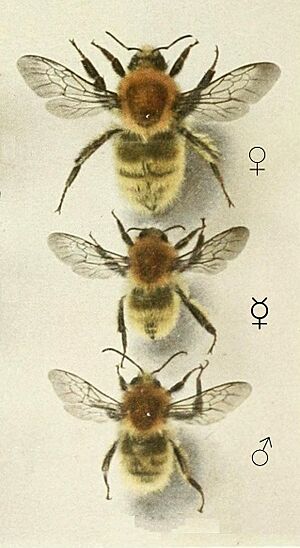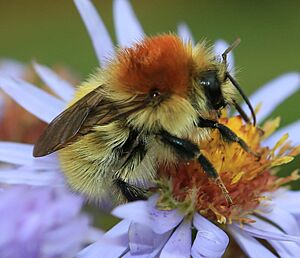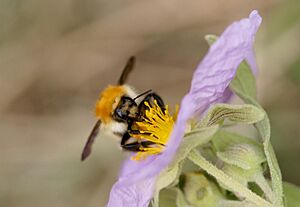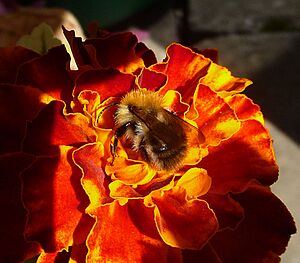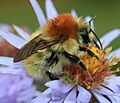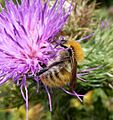Large carder bee facts for kids
Quick facts for kids Large carder bee |
|
|---|---|
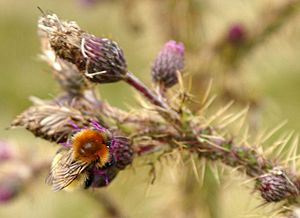 |
|
| Bombus muscorum agricolae – the Shetland subspecies | |
| Scientific classification | |
| Genus: |
Bombus
|
| Species: |
muscorum
|
| Synonyms | |
|
Apis muscorum Linnaeus, 1758 |
|
The Bombus muscorum, also known as the large carder bee or moss carder bee, is a type of bumblebee. These fuzzy insects are found across Eurasia, from Ireland all the way to Mongolia. However, you'll find them most often in the British Isles.
Large carder bees are social insects, meaning they live together in groups called colonies. The queen bee mates with only one male to start her new family. They build their nests on or just under the ground in open grassy areas and usually look for food very close to their homes. Sadly, the number of large carder bees has dropped a lot recently because their natural homes are disappearing. Because of this, the European Red List of Bees currently lists B. muscorum as a vulnerable species in Europe.
Contents
What is the Large Carder Bee?
The large carder bee was first described in 1758 by a famous scientist named Carl Linnaeus. He gave it the scientific name Apis muscorum. The word muscorum comes from a Latin word meaning "moss," which fits because these bees often use moss to build their nests.
The Bee Family Tree
B. muscorum belongs to a large group of insects called Hymenoptera. This group includes bees, wasps, ants, and sawflies. Within this big family, the large carder bee is part of the Bombus genus, which includes all bumblebees. It's also part of a smaller group within bumblebees called Thoracobombus. There are at least seven different types, or subspecies, of B. muscorum. Some of these, like B. muscorum sladeni and B. muscorum smithianu, are found in the United Kingdom and look a bit different based on their fur color.
What Does the Large Carder Bee Look Like?
The large carder bee has a face that's a bit long and a long tongue. Its body is covered in ginger-colored fur, especially on its head, middle section (thorax), and back part (abdomen). Sometimes, the abdomen can be a darker brownish color. In some types of these bees, you might see black hairs mixed in with the ginger ones. Some even have a completely black underside.
These bees look a lot like another common bee called the Bombus pascuorum. However, the large carder bee is generally bigger.
- A queen bee is about 17–19 millimeters (about 0.7 inches) long, with a wingspan of 32–35 millimeters (about 1.3 inches).
- Worker bees are smaller, about 10–16 millimeters (about 0.4–0.6 inches) long, with a wingspan of 26–29 millimeters (about 1–1.1 inches).
- Male bees are about 13–15 millimeters (about 0.5–0.6 inches) long, with a wingspan of 26–29 millimeters (about 1–1.1 inches).
Where Do Large Carder Bees Live?
You can find B. muscorum across a wide area of Eurasia. They live from Ireland in the west all the way to Mongolia in the east. They have been seen as far north as Scandinavia and Russia, and as far south as Crete. However, they are quite rare in most places.
In the United Kingdom, their numbers have dropped a lot since the 1970s. While they used to be found everywhere in the British Isles, now they are mostly found in small groups along the coast. Other bee species, like the Bombus pascuorum, seem to be taking their place in some parts of Northern Britain. Still, you can find quite a few of them in Northern Scotland. Because their numbers are declining, the IUCN (International Union for Conservation of Nature) has listed B. muscorum as vulnerable in Europe.
Bee Homes
Large carder bees like to live in open areas like moors, grasslands, and salt marshes. They build their nests on the ground or just slightly under it. In the British Isles, they often nest in open places near the coast. In the north, they live in moorland and machair (grassy plains). In the south, they prefer coastal marshes, stony beaches, and chalky grasslands. Their colonies are usually small, with only about 20 to 100 worker bees.
What Do Large Carder Bees Eat?
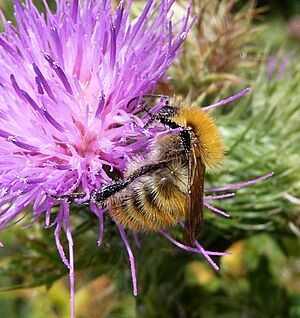
B. muscorum eats many different kinds of plants, depending on what's growing nearby. They especially like flowers from the pea family (Fabaceae), figwort family (Scrophulariaceae), mint family (Lamiaceae), and daisy family (Asteraceae). Some of their favorite foods include clover, bird's-foot trefoil, vetches, and thistles. Flowers with long tubes (called corollas) are very important to these bees because of their long tongues.
The Life Cycle of a Large Carder Bee Colony
At the end of summer, a colony produces new queen bees. These new queens mate and then go into hibernation for about nine months. From March to May, they wake up and start looking for a good place to build a new nest.
Once a queen finds a suitable spot, she lays a small group of eggs. When these eggs hatch, the queen takes care of the young bees (larvae) until they grow up and turn into pupae. These pupae then become worker bees. From June onwards, the queen continues to produce more worker bees. Later in the summer, from July to September, new male bees and queens are born, and they mate to continue the cycle.
How Large Carder Bees Reproduce
How Genes Are Passed On
Like many bees, B. muscorum has a special way of passing on genes called haplodiploidy.
- Diploid queens (meaning they have two sets of chromosomes) lay fertilized eggs. These eggs develop into diploid worker bees and new queens.
- Haploid males (meaning they have only one set of chromosomes) are born from unfertilized eggs.
- Worker bees can also lay unfertilized eggs, which will develop into male bees.
Mating Habits
It is believed that B. muscorum queens usually mate only once with a single male to start their new colony. This means there is less genetic variety within one colony compared to species where queens mate with many males. Because of this, B. muscorum can be more affected by inbreeding. Inbreeding happens when closely related bees mate, which can lead to weaker offspring.
Male Mating Strategies
Male large carder bees use a special strategy to find mates. They choose a spot, like a perch, outside a mature nest and wait. When they see another bee flying nearby, they chase after it for a few seconds. They are trying to either scare away other male competitors or mate with a female. After the chase, one of the males will land back at the perch near the nest.
The Problem of Inbreeding
Because their populations are small and due to their unique way of passing on genes, B. muscorum is very sensitive to inbreeding. When males mate with queens that are closely related, they can produce male bees that are less fertile and have weaker immune systems. Studies have shown that many B. muscorum groups in the Hebrides (islands off Scotland) have recently experienced a sharp drop in numbers, which makes inbreeding more likely. In recent years, these less healthy male bees have become a bigger part of the populations in the British Isles, showing that inbreeding is increasing.
Bee Behavior
Finding Food
Large carder bees don't fly very far to find food. They have been seen going no further than 500 meters (about 1,640 feet) from their nest. Often, they forage even closer, within 100 meters (about 330 feet) of their home. Individual bees often visit the same spots to find food. Scientists call them "doorstep foragers" because they tend to use food sources very close to their nests more often than other types of bees. This limited foraging range might be one reason why their numbers are declining.
Nest Building
B. muscorum builds its nest on the ground or just under it. They gather moss and dry grass and "card" it together to cover their nest. This is how they got the name "moss carder bee." They rarely cross large bodies of water (more than 10 kilometers or 6 miles) to find a nesting site. Once a nest is built, these bees are known to be quite aggressive. They will readily attack anything that comes too close to their nest, biting and stinging at the same time.
Threats to Large Carder Bees
Parasites: Crithidia bombi
Large carder bees can get sick from a tiny parasite called Crithidia bombi. They can catch it from other infected bees in their nest or from visiting flowers that have been contaminated by sick bees. When bees get this infection, it can make them and their whole colony weaker. The problem is worse in bee populations that have less genetic variety. As B. muscorum populations continue to lose their genetic diversity, the impact of these parasites grows, pushing these already threatened bees closer to extinction.
Losing Their Homes
In recent decades, a lot of the natural homes of B. muscorum in Europe have been destroyed. This is mainly due to more intense farming practices. Many areas rich in flowers, where these bees used to find food, have been removed for commercial farms. B. muscorum cannot travel as far as other bumblebee species, which makes them even more vulnerable to losing their habitat. As a result, their populations have dropped dramatically.
Their Status
The IUCN currently lists B. muscorum as vulnerable in Europe. Their numbers are decreasing in Britain, and there is a special program trying to help them recover. Many other European countries are also seeing fewer of these bees. Estonia lists them as vulnerable, while Germany and the Netherlands consider them endangered.
Sea Walls as Safe Havens
Interestingly, B. muscorum is often found living on sea wall flood defenses, which are managed by the Environment Agency. Their nests can be found on the flat grassy areas between the sea and the "borrowdyke," which is a pond behind the sea wall. Since the grasslands on these sea walls are usually left natural, they have become important homes for rare insect species like B. muscorum. Scientists are currently studying how to maintain these sea walls to help protect these special bee populations.
Images for kids
-
A male moss carder bee in Deepsyke Forest, Peeblesshire, Scotland on an Aster flower.
-
An adult moss carder bee on thistle, covered in pollen
-
A moss carder bee on the flower of the French marigold in Cradley, Herefordshire, England.


